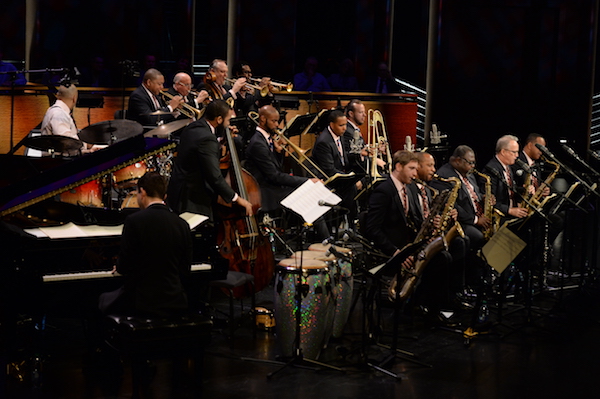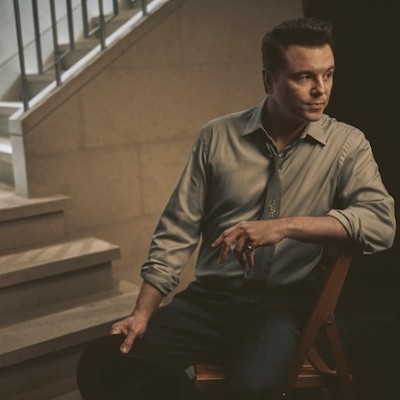Dec 9, 2025 12:28 PM
In Memoriam: Gordon Goodwin, 1954–2025
Gordon Goodwin, an award-winning saxophonist, pianist, bandleader, composer and arranger, died Dec. 8 in Los Angeles.…

The Jazz at Lincoln Center performs an homage to Dizzy Gillespie during the “Celebrating Dizzy Gillespie” concert series, which ran from Jan. 26-28 at New York’s Jazz at Lincoln Center.
(Photo: Frank Stewart)Between Jan. 26 and 28, Jazz at Lincoln Center devoted its three performing spaces to programs exploring the legacy of the seminal trumpeter-composer Dizzy Gillespie, whose centennial birthday arrives on Oct. 21. In the Appel Room, JLCO bassist Carlos Henriquez presented a crackling “A Latin Side of Dizzy” concert; at Dizzy’s Club Coca-Cola, trumpeters Bruce Harris and Theo Croker presented separate programs on the latter two nights.
For the main event, at Rose Theater, Jazz at Lincoln Center Orchestra trombonist Vincent Gardner served as musical director for a concert by JLCO devoted primarily to what Gillespie and his associate-acolyte, composer-arranger Tadd Dameron, were up to in the 1940s, when bebop was nascent, with particular attention to lesser-known works from their respective canons.
Artistic Director Wynton Marsalis delivered introductory remarks. Then Gardner—a J.J. Johnson devotee who displayed his bebop erudition on the excellent 2012 Steeplechase sextet album The Good Book, Volume 3: The Book of Bebop—set the stage, describing the New York milieu of the first half of the 1940s as “a think tank of ideas.”
He pointed out that, after Gillespie left Cab Calloway in 1941, he freelanced, playing trumpet and contributing arrangements to a number of big bands, among them “Grand Central Getaway” for the Jimmy Dorsey Orchestra. Gillespie played it with Dorsey’s band on one of several extant radio airchecks (he taught Dorsey’s trumpeters the fingerings), not long before Dorsey commercially recorded it in July 1944. Gardner presented his meticulous transcription as the evening’s opening number.
After an opening passage that was identical to Charlie Parker’s “Red Cross,” a September 1944 recording (Parker and Gillespie had played together in the Billy Eckstine Orchestra that summer, and in Earl Hines’ Orchestra during 1943), and contained several other classic bebop motifs, alto saxophonist Sherman Irby, goosed by brass riffs and drummer Ali Jackson’s big beat, took a few choruses that refracted Dorsey’s distinctive style.
Marsalis, using a mute, exchanged a chorus with pianist Dan Nimmer, then took a few more in what used to be called a “running trumpet” style, leading to a saxophone-brass discussion.
There followed trombonist Chris Crenshaw’s transcription of the Dizzy Gillespie Orchestra’s 1949 RCA-Victor version of Lester Young’s “Jumpin’ With Symphony Sid.” After a rapid-fire trumpet soli section, Marsalis—who operated at a high level of intensity and creativity throughout from the fourth trumpet chair—uncorked a vertiginous solo, tossing off dazzling Dizzyisms in the second chorus, setting up a third chorus in which the entire orchestra turned to watch him ascend to stratospheric levels. Following the recording’s solo order, trombonist Elliott Mason brought everyone back to earth with a swinging, bluesy statement.
Master conguero-rumbero Román Díaz took the stage to channel Chano Pozo on George Russell’s “Cubano Be, Cubano Bop,” recorded by Gillespie in 1947, chanting the famous introduction in his inimitable manner, then blending into the ensemble when lead trumpeter Greg Gisbert and his section partners stated the theme. After Gisbert’s impeccable solo, Díaz generated a conversational, no-pyrotechnics solo on the congas.
Gardner then told the back story of “One Bass Hit,” a 1946 RCA recording that introduced bass icon Ray Brown to the broader jazz audience. Bassist Russell Hall—subbing for Henriquez—offered his interpretation of Brown’s famous solo with a resonant catgut sound and melodic sensibility. There followed cogent, elegant solos by trumpeter Marcus Printup and Crenshaw.
After trumpeter Kenny Rampton said his piece on Gillespie’s iconic arrangement of “I Can’t Get Started,” the set ended with an obscure Dameron number titled “Pan-Dameronium,” which, as Gardner pointed out, only survives from an August 1947 aircheck of Gillespie’s band at the Down Beat Club on 52nd Street, on which the radio announcer talks over the final ensemble passage before the piece cuts off, two bars or so from the end.
Transcribed by Mark Lopeman, this barnburner, a “Sweet Georgia Brown” contrafact, opened with Paul Nedzela’s baritone solo, setting the stage for a Marsalis declamation that began modestly and again navigated the outer partials.
Nimmer’s solo filled in for Milt Jackson’s vibraphone passage on the aircheck and Jackson emulated a tap dancer in the Papa Jo Jones manner on his own chorus, before New York radio personality and jazz historian Phil Schaap, a long-time contributor to JLCO, cut the band short with a pitch-perfect summation.
To open set two, a tentet played Gardner’s transcription of Dameron’s “Casbah,” which the composer documented with that configuration on a 1949 Capitol date with Fats Navarro. Gardner described it as “a rare example of the intersection between jazz and the operatic world,” the wordless melody statement on the original recording by soprano singer Rae Pearl, channeled for this occasion by Brandie Sutton. After Printup offered his impression of Navarro’s solo, and a four-horn shout chorus, Ted Nash uncorked an alto solo that channeled the essence of Charlie Parker.
Gardner then introduced “Pullamo,” a flagwaver recorded by pianist Buddy Johnson in December 1947 that is attributed to the Brooklyn trombonist Steve Pulliam, but, Gardner said, contains so many Dameronisms “that no one else could have done the arrangement.” After a Dameron-inflected opening passage, Gardner took a scat chorus (emulating Arthur Prysock’s on the original), followed by a soulful Victor Goines tenor solo in the tradition of Wardell Gray, then a Fats Navarro-esque passage by Marsalis and a half-chorus from Crenshaw.
Nimmer’s efflorescent solo and a long band soli highlighted a performance of Dameron’s “Swift As The Wind” (from the 1962 album The Magic Touch [Riverside]) that cut to the essence of the title, propelled by Jackson’s crisp beats. Another ferocious Marsalis solo highlighted Ernie Wilkins’ “Dizzy’s Business,” written for Gillespie’s great 1956 big band.
Gardner’s informative soliloquy on the art of scat-singing introduced “Jump Did Le Ba,” a May 1949 RCA record that opened with band vocalist Joe Carroll’s scat choruses, followed by declamations from Gillespie and Yusef Lateef on tenor saxophone. On this evening, propelled by Díaz’s Ray Barretto style congas and Jackson’s rumbling beat, Crenshaw and Gardner engaged in five or six rounds of creative scatting, Marsalis and Gisbert offered more impeccable upper register trumpet, and Blanding uncorked a bluesy solo with a gruff, airy tone.
The evening ended, fittingly, with Gardner’s “Ooo-Yadoodle-E-Blu For Me And You: A Bop Celebration Of Dizzy Gillespie.” In his prefatory remarks, Gardner said that it had scat language, “a quasi-Lebanese rhythm I heard on a record Dizzy did after the State Department tour,” and a band chorus of the lyric “Dizzy is a drum.”
There were Ellingtonian voicings in the opening passage, hints of “Dizzy Atmosphere” in the fanfare that followed, a movement in which the flutes and trombones dialogued, an evocative, full-toned trombone solo by Gardner (his only instrumental declamation of the evening), a penetrating flute solo by Ted Nash, and ingenious treble register exploring by Nimmer. DB

Goodwin was one of the most acclaimed, successful and influential jazz musicians of his generation.
Dec 9, 2025 12:28 PM
Gordon Goodwin, an award-winning saxophonist, pianist, bandleader, composer and arranger, died Dec. 8 in Los Angeles.…

Flea has returned to his first instrument — the trumpet — and assembled a dream band of jazz musicians to record a new album.
Dec 2, 2025 2:01 AM
After a nearly five-decade career as one of his generation’s defining rock bassists, Flea has returned to his first…

“It’s a pleasure and an honor to interpret the music of Oscar Peterson in his native city,” said Jim Doxas in regard to celebrating the Canadian legend. “He traveled the world, but never forgot Montreal.”
Nov 18, 2025 12:16 PM
In the pantheon of jazz luminaries, few shine as brightly, or swing as hard, as Oscar Peterson. A century ago, a…

Dec 11, 2025 11:00 AM
DownBeat presents a complete list of the 4-, 4½- and 5-star albums from 2025 in one convenient package. It’s a great…

Seth MacFarlane takes a turn from his television and film career to sing arrangements made for Frank Sinatra, but never recorded.
Nov 18, 2025 12:04 PM
“I’m not gonna lie to you — I don’t know why I thought this was about The Naked Gun, but I’m happy it’s…